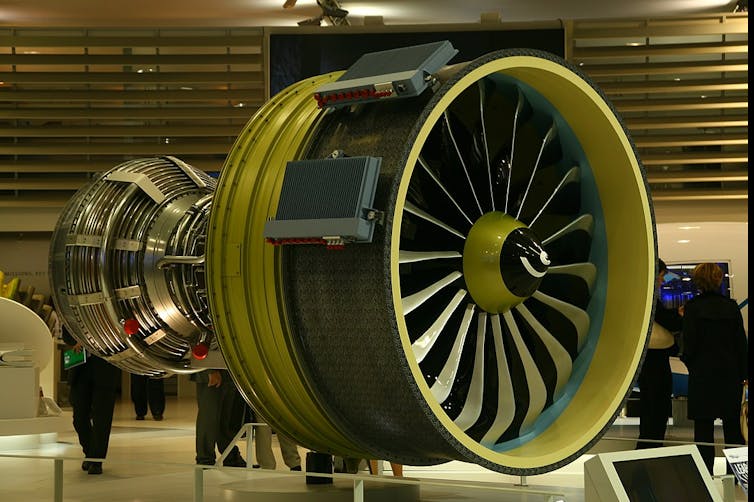Ecological transition: what if companies chose coopetition?
"I have a tall cappuccino for John..." A phrase John hears every morning at his Palo Alto Starbucks before jumping into his Tesla to drive to work in San Francisco. It's such a natural routine that John almost forgets that both his coffee and his car are the result of an unnatural business strategy: coopetition, a portmanteau combining cooperation and competition.

Anne-Sophie Fernandez, University of Montpellier; Audrey Rouyre, Montpellier Business School and Paul Chiambaretto, Montpellier Business School
The cup that John puts in his car's cup holder is the result of a collaboration between McDonald's and Starbucks, which, despite being major competitors in the fast food and takeaway beverage market, are closely associated in their policy of reducing food packaging waste. Similarly, the Tesla that John drives on California's roads is built from numerous parts and technologies sourced from Tesla's fierce competitors, such as Daimler and Toyota.
The idea that coopetition, i.e., alliances between competing companies, can lead to new innovations is quite widespread. However, as we explain in a book, reducing the benefits of coopetition to the simple creation of economic or financial value is simplistic. Over the past decade, various studies in management science have shown how such strategies can develop not only economic value, but also societal and environmental value. However, developing the use of these strategies seems to require changes in European law.
When pooling resources means efficiency
Defining what constitutes a green innovation is not always easy, and two complementary approaches can be considered: by product and by design process.
The first is to apply the label "green" if the product designed is more environmentally friendly than existing products. Following this logic, an electric car (such as John's Tesla) can be considered a green innovation since it pollutes less than a car powered by fossil fuels.
Developing a greener product often represents a more radical and risky innovation than a non-green innovation. To develop such innovations, the resources and skills of a single company are often insufficient. It therefore seems necessary to call on the expertise of an entire sector. This is how competing companies are led to pool their know-how, technologies, and knowledge to develop new green standards within their industries.
To ensure the ecological transition of the aeronautics industry, for example, eleven competitors, including Airbus, Dassault Aviation, and Saab, have joined forces to create the Cleansky network, which comprises 54 companies of all sizes, with the aim of inventing and producing the green aircraft of tomorrow. Also in the aviation sector, CFM International, a joint venture between two competing engine manufacturers, Safran and General Electric, has succeeded in developing jet engines that reduce carbon dioxide emissions by more than 15% and nitrogen dioxide emissions by 50%. Neither Safran nor General Electric was capable of developing these new green technologies on its own. In the space sector we studied, MTG was developed by the two leaders in satellite construction, Thales Alenia Space and OHB, with the aim of monitoring weather developments and potentially predicting future natural disasters.

The second approach focuses on the process used to produce the same end product: does it consume fewer resources? From this perspective, a new gasoline or diesel car can be considered a green innovation if its construction requires less energy or consumes fewer resources than competing models.
Pooling competing production or logistics chains can therefore prove effective. This was the strategy adopted by Nestlé in the mid-2000s when it joined forces with Pladis, one of its competitors in the United Kingdom, to carry out joint deliveries. With the slogan "We compete on the shelf, not in the back of a truck," the two groups have managed to save an average of 28,000 km of deliveries each year, or 95,000 liters of fuel and 250 tons ofCO2.
For businesses of all sizes
It is not only large corporations that are affected. As we show in our work, many start-ups and SMEs are partnering with competitors to strengthen their innovation capacity. This is often a matter of survival for them because, being smaller, these companies do not always have sufficient resources to develop products and bring them to market.

Every Monday, whether you are a manager looking for strategies or an employee wondering about the choices made by your superiors, receive the keys to professional research and advice from our experts in our themed newsletter "Entreprise(s)" (Business(es)) in your inbox.
The same applies to issues related to CSR and ecological transition. SMEs would like to address these issues, especially as their customers and stakeholders are becoming increasingly sensitive to them. However, given their limited resources, they often have to make trade-offs that force them to prioritize their day-to-day operations at the expense of their environmental commitments.
Cooperating with competitors can then enable them to have the necessary resources to both continue their activities and engage in CSR or ecological transition initiatives. In South Africa, several small competing vineyards that did not have the capacity to develop their own bottle recycling system have thus acted collectively to develop solutions for recycling glass and limiting the waste of resources.
Large corporations and SMEs can also interact. For example, Nestlé Waters and Danone, both competitors in beverage distribution, decided in 2017 to join forces and invest in the small Californian start-up Origin Materials, which develops plastic bottles made entirely from sustainable and renewable resources.
Necessary legislative changes
If coopetition is virtuous and helps companies in their ecological transition, why aren't more companies committing to this approach?
One reason for this is the tensions generated by these paradoxical strategies. Cooperating and competing at the same time creates tensions that are often difficult to ignore. Our study of the space industry suggests that particular attention should be paid to information sharing and protection in this regard.
Beyond that, there is still some uncertainty as to the legality of such alliances between competitors. Article 101 of the Treaty on the Functioning of the European Union considers "all agreements between undertakings, decisions by associations of undertakings and concerted practices which may affect trade between Member States and which have as their object or effect the prevention, restriction or distortion of competition within the internal market."
However, it is not always easy to prove that a coopetition agreement will not restrict or distort competition. When we looked at the real estate sector in Europe, we observed that coopetition strategies can lead to higher property prices, thereby reducing customers' purchasing power but bringing more value to sellers.
This is why regulators in the European Union, as well as in Australia, are increasingly considering explicitly incorporating exemptions to prevent competition law from preventing competitors from working together if the agreement accelerates the ecological transition of the companies in question.
The balance to be struck between competition law and environmental law remains subtle, however, for example when airlines join forces with their rail competitors. In any case, changes to the legal framework seem necessary to support changes in corporate practices in light of the scale of the environmental challenge that lies ahead.
Anne-Sophie Fernandez, Senior Lecturer in Strategy, University of Montpellier; Audrey Rouyre, Assistant Professor in Strategic Management, Montpellier Business School and Paul Chiambaretto, Associate Professor and Director of the Pégase Chair, Montpellier Business School
This article is republished from The Conversation under a Creative Commons license. Readthe original article.